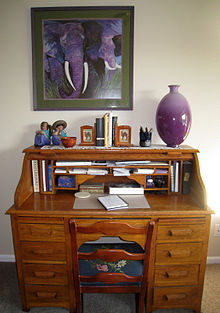การอุปลักษณ์เดสก์ท็อป

ในการคอมพิวเตอร์ การอุปลักษณ์เดสก์ท็อป เป็นการอุปลักษณ์ส่วนต่อประสานแบบหนึ่ง ที่ใช้ในส่วนต่อประสานกราฟิกกับผู้ใช้ เพื่อช่วยให้ผู้ใช้โต้ตอบกับคอมพิวเตอร์ได้ง่ายขึ้น [1] การอุปลักษณ์เดสก์ท็อปเรียกจอภาพว่าเป็นภาพมุมสูง (top) ของโต๊ะเขียนหนังสือ (desk) การอุปลักษณ์เดสก์ท็อปได้รับการอิมพลีเมนต์อยู่ในสิ่งแวดล้อมเดสก์ท็อปจำนวนมาก
ความเป็นมา
[แก้]คณะผู้สร้างแนวคิดการอุปลักษณ์เดสก์ท็อป คือ Alan Kay, David C. Smith และคณะ ที่ Xerox PARC ในปีค.ศ. 1970 โดยมีการอธิบายแนวคิดนี้อย่างละเอียดในชุดแอปพลิเคชันซอฟต์แวร์อันเป็นนวัตกรรมใหม่ที่พัฒนาโดยนักวิทยาศาสตร์ของ PARC ตลอดทศวรรษต่อมา คอมพิวเตอร์เครื่องแรกที่ใช้การอุปลักษณ์เดสก์ท็อปเวอร์ชันแรกๆ คือเครื่อง Xerox Alto รุ่นทดลอง [2] [3] และคอมพิวเตอร์เชิงพาณิชย์เครื่องแรกที่ใช้ส่วนต่อประสานประเภทนี้คือ Xerox Star การใช้ตัวควบคุมหน้าต่าง เพื่อล้อมรอบข้อมูลที่เกี่ยวข้องมีมาก่อนการอุปลักษณ์เดสก์ท็อป โดยมีเวอร์ชันดั้งเดิมปรากฏใน "มารดาแห่งการสาธิตทั้งหมด" (The Mother of All Demos) ของ ดักลาส เองเกลบาร์ต [4] แม้ว่า PARC จะรวมไว้ในสภาพแวดล้อมของภาษาสมอลล์ทอล์กก็ตาม [5]
กระบวนทัศน์กระดาษ
[แก้]
กระบวนทัศน์กระดาษ หมายถึง กระบวนทัศน์ที่ใช้โดยคอมพิวเตอร์และระบบปฏิบัติการสมัยใหม่ส่วนใหญ่ กระบวนทัศน์กระดาษประกอบด้วยข้อความสีดำบนพื้นหลังสีขาว ไฟล์ภายในโฟลเดอร์ และ "เดสก์ท็อป" กระบวนทัศน์กระดาษถูกสร้างขึ้นโดยบุคคลและองค์กรจำนวนมาก เช่น ดักลาส เองเกลบาร์ต, Xerox PARC และ Apple Computer นับเป็นความพยายามที่จะทำให้คอมพิวเตอร์เป็นมิตรกับผู้ใช้มากขึ้นโดยทำให้มีลักษณะคล้ายกับสถานที่ทำงานทั่วไปในยุคนั้น (ด้วยกระดาษ แฟ้ม และเดสก์ท็อป) [6] เอนเกลบาร์ตนำเสนอต่อสาธารณะเป็นครั้งแรกในปี พ.ศ. 2511 ในสิ่งที่ปัจจุบันเรียกว่า "มารดาแห่งการสาธิตทั้งหมด"
อ้างอิง
[แก้]- ↑ "Desktop Metaphor". www.csdl.tamu.edu. คลังข้อมูลเก่าเก็บจากแหล่งเดิมเมื่อ 2001-02-22. สืบค้นเมื่อ 2011-06-09.
- ↑ Koved, Larry; Selker, Ted (1999). "Room with a view (RWAV): A metaphor for interactive computing". IBM TJ Watson Research Center. CiteSeerx: 10.1.1.22.1340.
- ↑ Thacker, Charles P., et al. Alto: A personal computer. Xerox, Palo Alto Research Center, 1979.
- ↑ Reimer, Jeremy (2005). "A History of the GUI (Part 2)". Ars Technica. สืบค้นเมื่อ 2009-09-14.
- ↑ Reimer, Jeremy (2005). "A History of the GUI (Part 3)". Ars Technica. สืบค้นเมื่อ 2009-09-14.
- ↑ "Realworld Desk".
สิ่งแวดล้อมเดสก์ท็อปและตัวจัดการหน้าต่าง | |||||||||
|---|---|---|---|---|---|---|---|---|---|
| สิ่งแวดล้อม เดสก์ท็อป |
| ||||||||
| เชลล์แบบกราฟิก |
| ||||||||
| X window managers (comparison) |
| ||||||||
| Wayland compositors |
| ||||||||
| อื่นๆ ที่เกี่ยวข้อง |
| ||||||||
Text is available under the CC BY-SA 4.0 license; additional terms may apply.
Images, videos and audio are available under their respective licenses.
